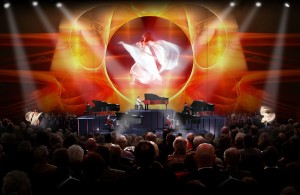FANTASIA SUITE
Imagine a new music. An innovative music embracing the virtuosity and romance of the past merging the universal appeal of today’s popular culture. Now imagine this new music presented in stage shows in a variety of media including film and video projects recordings internet and education including a twenty city international tour.
Fantasia Suite is a twenty-first century multi-media project for piano and orchestra written in a unique contemporary idiom. This body of work is quickly becoming a world wide post-minimalist Neo-Romantic movement spearheaded by the music of Carter Larsen. It is a new music that reaches back for its inspiration and then spanning centuries launches an entire new 21st century movement.

The pinnacle of Fantasia Suite is a dramatic uplifting show that crosses generations combining the elegance and passion of the concert hall with the energy of a visually stimulating stage show along the lines of Riverdance and Cirque du Soleil. The concerts are “musical experiences” highlighting multiple performers with light shows and visuals including graphics live video and CGI. Each show has a story or theme the first being “Arcadian Odyssey” the story of two lovers separated across time. Andrea Van de Kamp Chairman Emeritus of the Music Center Los Angeles declares Fantasia Suite to be “the music of the future”.
Fantasia Suite is touring recording and broadcast in collaboration with the Royal Philharmonic Orchestra. “As the Royal Philharmonic Orchestra has always represented the highest standards of artistic excellence we are enthusiastic to play a major role in the worldwide promotion of Fantasia Suite ” confirms Ian McClay general manager Royal Philharmonic Orchestra.
Fantasia Suite is being produced by Sheryl Carlin head of music production at Paramount and Dreamworks along with stage show producer Scott Lochmus. Writer and director Frank Capello will be directing and producing three films built on the music of Fantasia Suite. The first of which “Last Full Measure Devotion” is inspired by the thematic material and message behind Fantasia Suite. Fantasia Suite’s visuals have been produced by Leigh McClosky and Dave Wexler.
THE COSMOS SYMPHONIC SUITE
The musical compositions of Carter Larsen included in these recordings embody the essence of great art, which is by nature transcendent. This level of art far exceeds barriers of status quo categorization and exists in an interstitial space all of its own. The Cosmos Symphonic Suite goes beyond numerous boundaries, including limitations of genre, chronological time, instrumentation, and a monolithic sense of cultural identity.
One axiom of great art is that it naturally evolves out of established tradition. Great artists are obviously impacted by those iconic individuals who preceded them in the field, but rather than simply emulate the stylistic characteristics of their mentors, these individuals find their own voices and thereby extend the tradition. Larsen is a composer of this ilk. While emulation demonstrates an important level of understanding of an art form, innovation occurs when the artist truly understands music on a deeper level. This requires not only the mastery of idiosyncratic skills, but also confidence in an ability to express significance and an absolute clarity of artistic vision.
Many of the pieces in The Cosmos Symphonic Suite draw from the best elements of Romantic musical style. For example, consider Artasia Op. 233, which is reminiscent of Beethoven’s unique ability to craft the most beautiful, lyrical melodies and evoke a palpable, melancholic mood. Moreover, like Beethoven, Larsen utilizes the orchester in service of the music. When there are virtuosic passages in Larsen’s compositions, they appear as natural extensions of the music.
The Cosmos Symphonic Suite is composed for keyboards, orchestra and choir as well as a multitude of other instruments. Larsen uses a myriad of sonorous capabilities (e.g., the breadth of timbre and nuance) by writing music idiomatic to the orchestra. This quality is particularly evident in compositions like the Viamala, (4th Symphony) which is very well expressed through the instrumentation of a full symphony orchestra.
Larsen’s compositions exude the feeling of being very much “in the now.” Perhaps this is due to the fact that many of the works developed from the composer’s own improvisations at the piano. Like jazz, this type of approach requires superior musical knowledge (theoretical, compositional, etc.), creativity, sensitivity, and above all fearlessness.
As evidence of Larsen’s adventurous approach to rhythm, experience the Latin-influenced Madrish (11th Symphony) and its lilting syncopation and additive sense of meter; or the Afro Cuban-like rhythmic interplay.
Another commonality between jazz and Larsen’s work is an unmistakable and identifiable sound, one that invites and celebrates the individuality of the performer, yet simultaneously retains a certain level of artistic integrity and consistency. This uniqueness is most evident when musicians perform his works. As stated earlier in the preface, performers have the freedom to arrange each compositions in the order of their choosing. Larsen has honed in on the ability to create music that expresses his unique voice and allows for the individuality of the performer to be heard as well.

